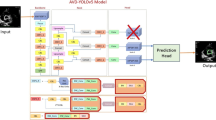Abstract
Purpose
To present newly developed software that can provide fast coronary artery segmentation and accurate centerline extraction for later lesion visualization and quantitative measurement while minimizing user interaction.
Methods
Previously reported fully automatic and interactive methods for coronary artery extraction were optimized and integrated into a user-friendly workflow. The user’s waiting time is saved by running the non-supervised coronary artery segmentation and centerline tracking in the background as soon as the images are received. When the user opens the data, the software provides an intuitive interactive analysis environment.
Results
The average overlap between the centerline created in our software and the reference standard was 96.0%. The average distance between them was 0.38 mm. The automatic procedure runs for 1.4–2.5 min as a single-thread application in the background. Interactive processing takes 3 min in average.
Conclusion
In preliminary experiments, the software achieved higher efficiency than the former interactive method, and reasonable accuracy compared to manual vessel extraction.
Similar content being viewed by others
References
(2008) The top ten causes of death—Fact sheet N310. World Health Organization, Geneva. http://www.who.int/entity/mediacentre/factsheets/fs310_2008.pdf
Budoff MJ et al (2006) Assessment of coronary artery disease by cardiac computed tomography: a scientific statement from the American Heart Association Committee on Cardiovascular Imaging and Intervention, Council on Cardiovascular Radiology and Intervention, and Committee on Cardiac Imaging Council on Clinical Cardiology. Circulation 114(16): 1761–1791
Fishman EK et al (2006) Volume rendering versus maximum intensity projection in CT angiography: what works best, when, and why. Radiographics 26(3): 905–922
Cemil K, Francis Q (2004) A review of vessel extraction techniques and algorithms. ACM Comput. Surv. 36(2): 81–121
Schaap M et al (2009) Standardized Evaluation Methodology And Reference Database For Evaluating Coronary Artery Centerline Extraction Algorithms. Med Image Anal (accepted)
Tizon X, (2002) Segmentation with gray-scale connectedness can separate arteries and veins in MRA. J Magn Reson Imaging 15(4): 438–
Wang C, (2007) Coronary artery segmentation and skeletonization based on competing fuzzy connectedness tree. Med Image Comput Comput Assist Interv Int Conf Med Image Comput Comput Assist Interv 10(Pt 1): 311–
Wang C et al (2008) An interactive software module for visualizing coronary arteries in CT angiography. Int J Comput Assist Radiol Surg 3(1): 11–18
Rosset A et al (2004) OsiriX: an open-source software for navigating in multidimensional DICOM images. J Digit Imaging 17(3): 205–216
Wang C, Smedby Ö (2008) An automatic seeding method for coronary artery segmentation and skeletonization in CTA. Midas J (2008 MICCAI workshop—grand challenge coronary artery tracking)
Falcao AX et al (1998) User-steered image segmentation paradigms: live wire and live lane. Graph Model Image Process 60(4): 233–260
Illingworth J, Kittler J (1988) A survey of the Hough transform. Comput Vis Graph Image Process 44(1): 87–116
Ibanez L et al (2005) The ITK software guide. Kitware Inc, Clifton Park
Sato Y et al (1997) 3D multi-scale line filter for segmentation and visualization of curvilinear structures in medical images. Cvrmed-Mrcas’97 1205: 213–222
Schaap M et al (2008) 3D segmentation in the clinic: a grand challenge II—coronary artery tracking. Midas J (2008 MICCAI workshop—grand challenge coronary artery tracking)
Abdulla J et al (2007) 64-multislice detector computed tomography coronary angiography as potential alternative to conventional coronary angiography: a systematic review and meta-analysis. Eur Heart J 28(24): 3042–3050
Funka-Lea G et al (2006) Automatic heart isolation for CT coronary visualization using graph-cuts. In: Third IEEE International Symposium on Biomedical imaging: nano to macro 2006, pp 614–617
Hennemuth A et al (2005) One-click coronary tree segmentation in CT angiographic images. Int Congr Ser 1281: 317–321
Marquering HA et al (2005) Towards quantitative analysis of coronary CTA. Int J Cardiovasc Imaging 21(1): 73–84
Author information
Authors and Affiliations
Corresponding author
Rights and permissions
About this article
Cite this article
Wang, C., Smedby, Ö. Integrating automatic and interactive methods for coronary artery segmentation: let the PACS workstation think ahead. Int J CARS 5, 275–285 (2010). https://doi.org/10.1007/s11548-009-0393-z
Received:
Accepted:
Published:
Issue Date:
DOI: https://doi.org/10.1007/s11548-009-0393-z




